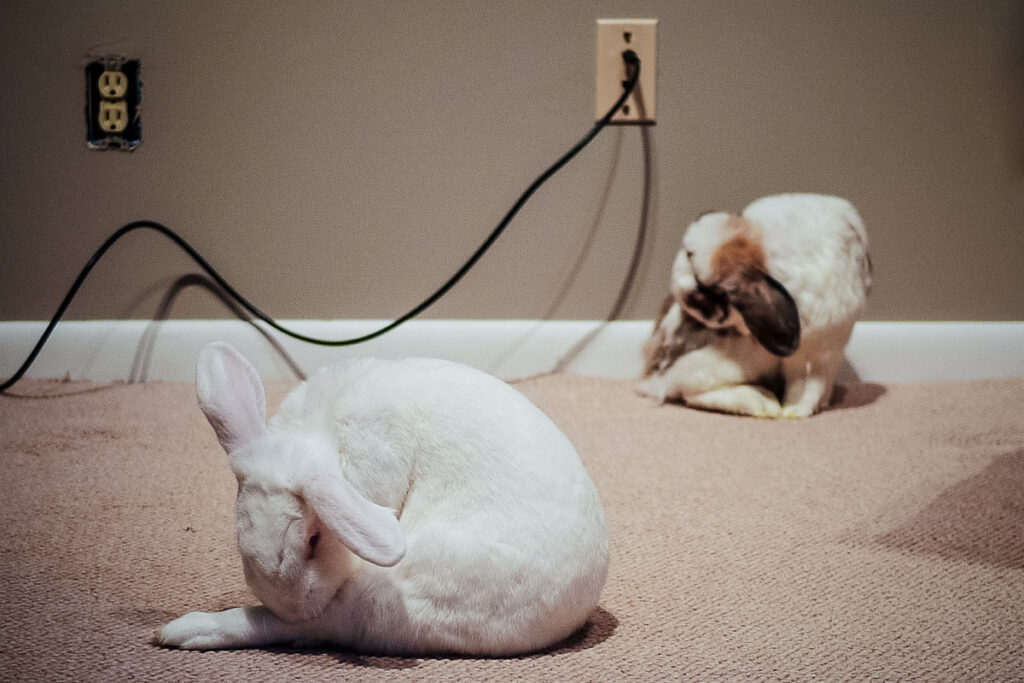FOR MOST RABBITS, a buddy of their own kind enhances life. By nature gregarious, they enjoy having someone around who speaks fluent Rabbit. They are also naturally hierarchical, which means that in any relationship, one will be top bunny and the other(s) subordinate. The process by which they work out their power positions can include fighting, biting, and other stressful events. Introductions fall into three major categories. Love at first sight happens rarely and requires no human intervention. The second and most common type is one of mutual uncertainty. Neither rabbit is clearly dominant, so they spend a few weeks establishing their positions before moving on to the ease and friendliness of domesticity. The third category is the one we will be discussing in this article. These are the bunnies who require human referees in order to avoid serious injury.
Margo DeMello operates a communal foster home where all fosters live and play together in a large warren-like group. Her own bunnies (mostly fostering “rejects”) also live together. Thus she spends quite a bit of time socializing new bunnies, not just to be house rabbits but to get along with other bunnies as well. Her methods may be helpful for house-rabbit people who want to introduce one more bunny to their own as well as for acquainted bunnies who have just started fighting. — Marinell Harriman
The two main points to work with when introducing unfamiliar rabbits or eliminating fighting among familiar ones are territory and stress. You need to work against the former and with the latter. The first thing we do is remove our bunny/ies from their own space and put him/them into a neutral space with the newcomer.
For this method to really work, however, the new space must be extremely unfamiliar, so that the bunnies are not merely too curious about their new surroundings to fight but actually are too scared. My favorite space for this is the car. I take two or more bunnies whom I want to introduce, or two who are fighting, put them loose on the seat, and take them out for a drive. Not only are they too frightened to fight, but they will instinctively snuggle together for security.
After the drive, they must be again introduced into a neutral space: a cage on top of the washing machine, the bathtub, or the extra bedroom. I also use friends’ houses for this stage.This is where I introduce the water bottle. I set the nozzle at “stream,” not “spray,” and then just watch and wait. If they begin to fight, they get sprayed in the face. They hate it, and after a few (or a lot) of sprays, they will have to stop fighting to wash themselves off.
This second stage lasts anywhere from a couple of hours to a few days. They will eventually stop fighting and either ignore each other or become friends. This process depends on your active and vigilant participation. If fighting is serious, the bunnies should be separated when unsupervised.
Once they seem to be getting along, they can be re-introduced into familiar territory. Often they start to fight again in their own space, so be ready with the water, and don’t give up. This third stage resolves itself when both bunnies either get along or have decided upon a hierarchy acceptable to both.This method is probably too extreme for the many rabbits who are in category 2, described above.
For them the emphasis is on time and patience rather than the more drastic element of stress. Nervous bunnies and those whose health is delicate should not be subjected to this kind of stress. But for others, for whom fighting is a real danger, the car ride/neutral space/water bottle technique may do the trick.
©Copyright Margo DeMello. All Rights Reserved. Republished with the permission of the author.
Will They Ever Be Friends? was originally published in House Rabbit Journal Volume II, No. 5

